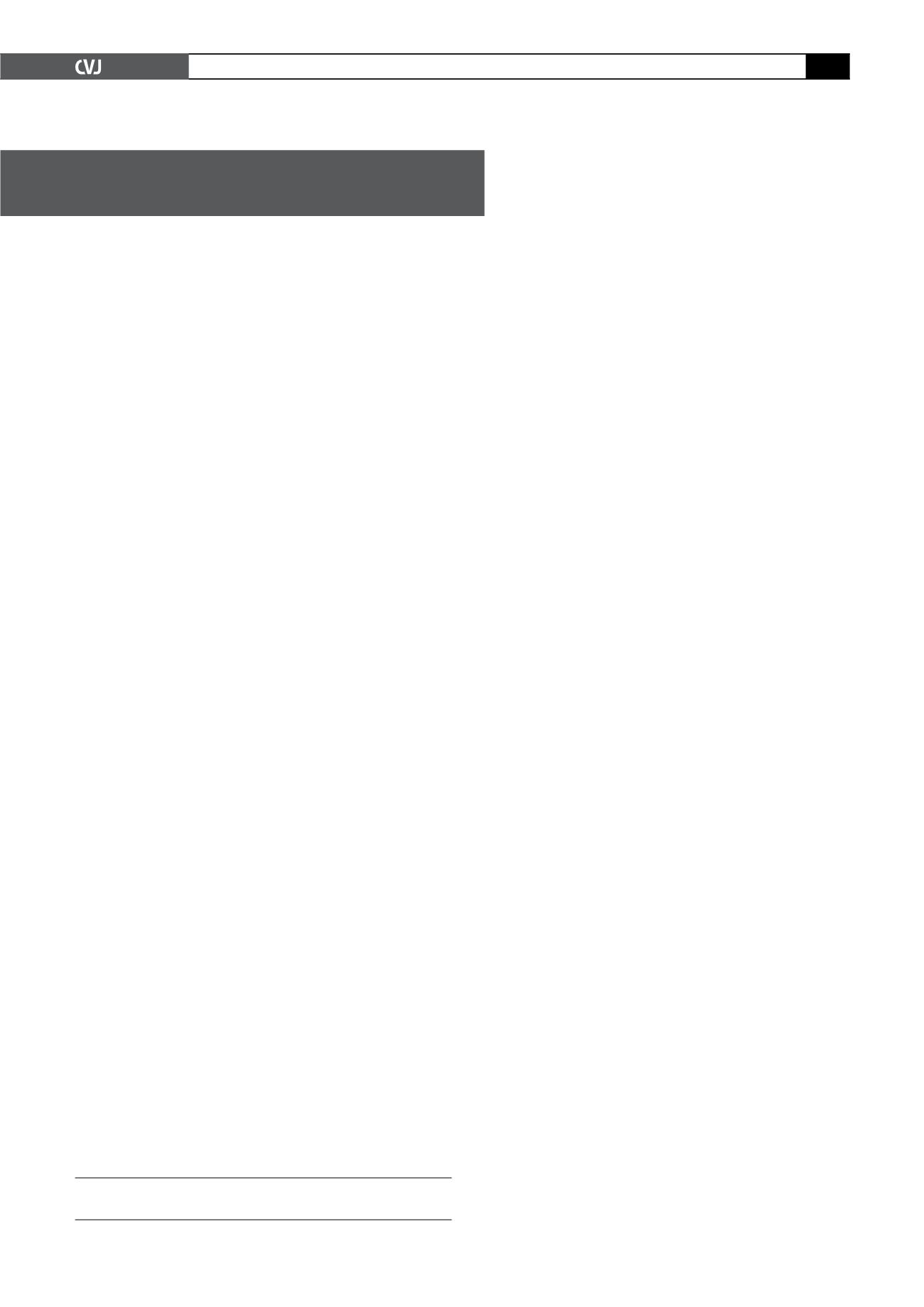
CARDIOVASCULAR JOURNAL OF AFRICA • Vol 21, No 1, January/February 2010
AFRICA
43
Cardiovascular Topics
Is fenofibrate a cost-saving treatment for middle-aged
individuals with type 2 diabetes? A South African
private-sector perspective
FRANCOIS WESSELS
Summary
Introduction:
This project was based on the FIELD trial.
1
It is a localisation of the study by Carrington and Stewart.
2
The aim of the original study was to determine the impact
of fenofibrate therapy on healthcare costs of middle-aged
patients with type 2 diabetes at high risk of future cardio-
vascular events.
Methods:
The methodology used in the Carrington article
2
was adopted for this study. The clinical foundation for the
analysis was derived from the findings of the FIELD study.
1
All costs were sourced from electronic databases obtained
from private-sector South African funders of healthcare.
Event costs for the cardiovascular events were determined
and added to the treatment costs for the individual treat-
ment arms. The cost saving was determined as the difference
between the event costs saved and the additional treatment
costs associated with fenofibrate treatment. All costs were
reported as 2008 ZAR and a discount rate of 10% was used.
The study adopted a South African private-sector funder
perspective.
Results:
If the same approach is followed as in the Carrington
and Stewart study,
2
a cost saving of 18% results. This is the
difference between the total costs associated with the placebo
and fenofibrate arms, respectively (R3 480 471 compared to
R2 858 598 per 1 000 patient years for the placebo and fenofi-
brate arms, respectively). The total costs were determined as
the sum of associated event costs and treatment costs for each
of the comparators.
Conclusions:
Based on this exploratory analysis, it seems that
Lipanthyl
®
treatment in middle-aged patients resulted in a
cost saving due to the prevention of cardiovascular events
when it was used in the treatment of type 2 diabetics, as in
the FIELD study. It should therefore be considered to be cost
effective, even when just the cardiovascular risk reduction
effect is considered.
Keywords:
type 2 diabetes, pharmaco-economics, fibrate thera-
py, cardiovascular disease
Submitted 13/4/09, accepted 13/1/10
Cardiovasc J Afr
2010;
21
: 43–46
DOI: CVJ-21.003
The Lipanthyl Intervention and Event Lowering in Diabetes
(FIELD) study was a multinational, randomised trial of 9 795
patients aged 50 to 75 years with type 2 diabetes mellitus.
Eligible patients were randomly assigned to receive Lipanthyl
200 mg/day (
n
=
4 895) or matching placebo (
n
=
4 900).
At each clinic visit, information concerning laser treatment
for diabetic retinopathy – a prespecified tertiary endpoint of the
main study – was gathered. Adjudication by ophthalmologists
masked to treatment allocation defined instances of laser treat-
ment for macular oedema, proliferative retinopathy, or other eye
conditions.
In a sub-study of 1 012 patients, standardised retinal photog-
raphy was done and photographs were graded with Early
Treatment Diabetic Retinopathy study (ETDRS) criteria to
determine the cumulative incidence of diabetic retinopathy and
its component lesions. Analyses were by intention to treat. This
study was registered as an international standard randomised
controlled trial, number ISRCTN64783481.
Based on the FIELD study,
1
a pharmaco-economic analysis of
the use of Lipanthyl in preventing cardiovascular events has been
developed. This study modelled the economics of Lipanthyl use
in type 2 diabetes patients, focusing on the cost-saving impact
of Lipanthyl treatment in reducing the risk of cardiovascular
events due to myocardial infarction (MI), stroke and the need
for angiography and revascularisation procedures. According
to Carrington and Stewart,
2
type 2 diabetes is associated with
increased risk for cardiovascular disease (CVD).
Significance of this and previous studies
Fibrates are currently receiving renewed attention in South
Africa. Lipanthyl has some of the strongest evidence in the class
of fibrates. The recent FIELD study
3,4
with its 9 795 patients
positioned Lipanthyl as perhaps the strongest contender in this
class.
The clinical argument has been well established by means
of the evidence-based medicine supporting Lipanthyl. Not only
has its efficacy been established in numerous clinical trials, but
its effectiveness in the reduction of clinical events has now been
proven by the FIELD study as well.
Pharmaco-economic evidence is critical in obtaining reim-
bursement in private healthcare in South Africa. With the FIELD
study, the opportunity is now presenting itself to develop not only
a compelling clinical argument but also a definitive economic or
value argument to support the use of Lipanthyl as an essential
component in lipid management.
Outcomes Consultants, Pretoria, South Africa
FRANCOIS WESSELS, MSc MTh,


